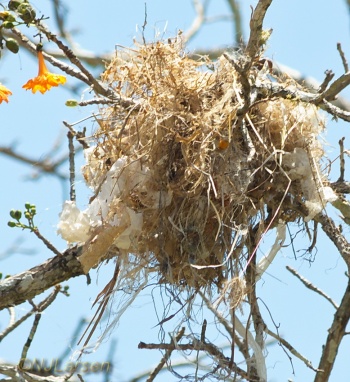m (date on photo) |
(id) |
||
| Line 3: | Line 3: | ||
;[[:Category: Myiozetetes |Myiozetetes ]] similis | ;[[:Category: Myiozetetes |Myiozetetes ]] similis | ||
==Identification== | ==Identification== | ||
| − | 16cm (6.25"). Medium sized. Short black bill. Olive above; wing coverts and inner remiges edged grayish white to buffy white; center crown brownish gray (little contrast with olive back). The semi-concealed crown patch is vermilion, as suggested by its second common name; Vermilion-crowned Flycatcher (note that this field mark can just be seen on the photo right). The long white eyebrow does not meet on nape. Sides of head dusky-blackish; throat white, rest of underparts bright yellow.<br /> '''Immature''': No crown patch, and wings and tail narrowly edged rufous. | + | 16cm (6.25"). Medium sized. Short black bill. Olive above; wing coverts and inner remiges edged grayish white to buffy white; center crown brownish gray (little contrast with olive back). The semi-concealed crown patch is vermilion, as suggested by its second common name; Vermilion-crowned Flycatcher (note that this field mark can just be seen on the photo right). The long white eyebrow does not meet on nape. Sides of head dusky-blackish; throat white, rest of underparts bright yellow.<br /> '''Immature''': No crown patch, and wings and tail narrowly edged rufous. |
| + | |||
| + | ====Variation==== | ||
| + | The most concealed crown patch is vermilion in [[Central America]] but orange-red in NW [[South America]] and even more orange in the south-east end of the range. | ||
====Similar Species==== | ====Similar Species==== | ||
| − | Similar to the [[Rusty-margined Flycatcher]], but | + | Similar to the [[Rusty-margined Flycatcher]], but adult Social Flycatcher lacks rufous in the wings, has olive (less brown) back, duller mask, and reddish-orange (not yellow-orange) crown patch. In some areas, the clearly best way to separate is by listening for different voice. Beware of juvenile Social Flycatcher that has rufous in the primaries, but also has pale edgings to coverts.<br /> |
Other superficially similar flycatchers have longer bill, yellow throat, white eye-brow meeting on nape or greyer head. | Other superficially similar flycatchers have longer bill, yellow throat, white eye-brow meeting on nape or greyer head. | ||
==Distribution== | ==Distribution== | ||
Revision as of 16:56, 9 September 2015
Alternative name: Vermilion-crowned Flycatcher
- Myiozetetes similis
Identification
16cm (6.25"). Medium sized. Short black bill. Olive above; wing coverts and inner remiges edged grayish white to buffy white; center crown brownish gray (little contrast with olive back). The semi-concealed crown patch is vermilion, as suggested by its second common name; Vermilion-crowned Flycatcher (note that this field mark can just be seen on the photo right). The long white eyebrow does not meet on nape. Sides of head dusky-blackish; throat white, rest of underparts bright yellow.
Immature: No crown patch, and wings and tail narrowly edged rufous.
Variation
The most concealed crown patch is vermilion in Central America but orange-red in NW South America and even more orange in the south-east end of the range.
Similar Species
Similar to the Rusty-margined Flycatcher, but adult Social Flycatcher lacks rufous in the wings, has olive (less brown) back, duller mask, and reddish-orange (not yellow-orange) crown patch. In some areas, the clearly best way to separate is by listening for different voice. Beware of juvenile Social Flycatcher that has rufous in the primaries, but also has pale edgings to coverts.
Other superficially similar flycatchers have longer bill, yellow throat, white eye-brow meeting on nape or greyer head.
Distribution
Central and South America
North-western Mexico to North-western Peru, North-eastern Argentina and Southern Brazil. Locally up to an altitude of 1500 m (4900 ft). Generally common.
Accidental vagrant to the United States with 1 record at Bentsen-Rio Grande Valley State Park in Texas.
Taxonomy
Subspecies[1]
- M. s. primulus:
- Western Mexico (southern Sonora to northern Sinaloa)
- M. s. primulus hesperis:
- Western Mexico (southern Sinaloa to southern Zacatecas, south-western Puebla and Oaxaca)
- M. s. primulus texensis :
- Eastern Mexico (southern Tamaulipas) to northern Costa Rica
- M. s. primulus columbianus:
- Tropical south-western Costa Rica to northern Colombia and northern Venezuela
- M. s. primulus similis:
- M. s. primulus grandis:
- M. s. primulus pallidiventris:
Habitat
River banks, ponds, gardens, pastures and clearings with scattered trees. Often in urban areas.
Behaviour
Often in small groups.
Diet
Hawks insects in the air or darts out to snatch them from shrubs, bushes and vegetaion. Also eats seeds, berries and small fruit; will also catch tadpoles in shallow water.
Vocalisation
Calls: sharp, harsh teeer or peeeeur, or a sad pe-ah or chee; also a repeated scolding wheer, a chipping wit, and a series of chu notes. Some variation in voice depending on subspecies.
Breeding
Nest is a rather large structure with side entrance.
References
- Clements, JF. 2008. The Clements Checklist of Birds of the World. 6th ed., with updates to December 2008. Ithaca: Cornell Univ. Press. ISBN 978-0801445019.
Recommended Citation
- BirdForum Opus contributors. (2025) Social Flycatcher. In: BirdForum, the forum for wild birds and birding. Retrieved 9 May 2025 from https://www.birdforum.net/opus/Social_Flycatcher
External Links
- A thread discussing identification is here. [[1]]





